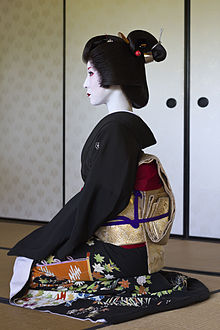


Miyagawa-chō (宮川町) is one of the hanamachi (花街, "flower towns") or geisha districts in Kyoto. 'Miya-gawa' means "Shrine River", referring to the nickname of the Kamo River just south of Shijō. During the Gion Festival the mikoshi (divine palanquin) of Yasaka Shrine used to be purified in the waters of this river.
Miyagawa-chō trademark consists of three interconnected rings, symbolizing the unity of the shrine/temples, the townspeople, and the teahouses.
What is now Miyagawa-chō was a place where entertainers gathered. Kabuki was performed in many small theaters on the banks of the Kamo River. Some of the teahouses were even boats that operated in the river. As kabuki was just then developing into a mass entertainment spectacle as known today, the area was very popular and Miyagawa-chō quickly grew into a full town of teahouses. The association with kabuki has gone, but the Minami-za kabuki theatre of Kyoto still stands on its historical spot on the east bank of the Kamo River. Today, Miyagawa-chō has its own kaburenjō, or theater where geisha dances are performed.
See also
- Kyōto hanamachi
- Gion, another district located just north of Miyagawachō
- Pontochō, another district on west side of Kamo river and just north
External links
- Kyo Odori Annual Dance Festival in Miyagawacho
- Debuted Maiko in Miyagawacho
References
- "京都の花街「宮川町歌舞練場」建て替え 元新道小に宿泊施設、一体的に再整備|社会|地域のニュース|京都新聞". 京都新聞 (in Japanese). Retrieved 2022-09-16.
- "Geisha, maiko from Kyoto's 5 'hanamachi' districts rehearse for joint performance". Mainichi Daily News. 2022-06-25. Retrieved 2022-09-16.
- "Geisha and young maiko in Kyoto prepare for annual spring dance performances". Mainichi Daily News. 2022-02-18. Retrieved 2022-09-16.
This Kyoto Prefecture location article is a stub. You can help Misplaced Pages by expanding it. |